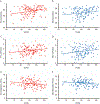The role of imagery in threat-related perceptual decision making
- PMID: 31192666
- PMCID: PMC6908763
- DOI: 10.1037/emo0000610
The role of imagery in threat-related perceptual decision making
Abstract
Visual perception is heavily influenced by "top-down" factors, including goals, expectations, and prior knowledge about the environmental context. Recent research has demonstrated the beneficial role threat-related cues play in perceptual decision making; however, the psychological processes contributing to this differential effect remain unclear. Since visual imagery helps to create perceptual representations or "templates" based on prior knowledge (e.g., cues), the present study examines the role vividness of visual imagery plays in enhanced perceptual decision making following threatening cues. In a perceptual decision-making task, participants used threat-related and neutral cues to detect perceptually degraded fearful and neutral faces presented at predetermined perceptual thresholds. Participants' vividness of imagery was measured by the Vividness of Visual Imagery Questionnaire-2 (VVIQ-2). Our results replicated prior work demonstrating that threat cues improve accuracy, perceptual sensitivity, and speed of perceptual decision making compared to neutral cues. Furthermore, better performance following threat and neutral cues was associated with higher VVIQ-2 scores. Importantly, more precise and rapid perceptual decision making following threatening cues was associated with greater VVIQ-2 scores, even after controlling for performance related to neutral cues. This association may be because greater imagery ability allows one to conjure more vivid threat-related templates, which facilitate subsequent perception. While the detection of threatening stimuli is well studied in the literature, our findings elucidate how threatening cues occurring prior to the stimulus aid in subsequent perception. Overall, these findings highlight the necessity of considering top-down threat-related factors in visual perceptual decision making. (PsycInfo Database Record (c) 2020 APA, all rights reserved).
Figures


Similar articles
-
Here Comes Trouble: Prestimulus Brain Activity Predicts Enhanced Perception of Threat.Cereb Cortex. 2017 Apr 1;27(4):2695-2707. doi: 10.1093/cercor/bhw104. Cereb Cortex. 2017. PMID: 27114179
-
Is threat detection Black and White? Race effects in threat-related perceptual decision-making.Emotion. 2022 Jun;22(4):616-626. doi: 10.1037/emo0000754. Epub 2020 May 28. Emotion. 2022. PMID: 32463276
-
It's all in the anticipation: How perception of threat is enhanced in anxiety.Emotion. 2016 Apr;16(3):320-7. doi: 10.1037/emo0000098. Epub 2015 Oct 19. Emotion. 2016. PMID: 26479770
-
Defining and 'diagnosing' aphantasia: Condition or individual difference?Cortex. 2023 Dec;169:220-234. doi: 10.1016/j.cortex.2023.09.004. Epub 2023 Sep 29. Cortex. 2023. PMID: 37948876 Review.
-
Top-down and bottom-up factors in threat-related perception and attention in anxiety.Biol Psychol. 2016 Dec;121(Pt B):160-172. doi: 10.1016/j.biopsycho.2016.08.006. Epub 2016 Aug 18. Biol Psychol. 2016. PMID: 27546616 Review.
Cited by
-
The Action Cycle Theory of Perception and Mental Imagery.Vision (Basel). 2023 Feb 14;7(1):12. doi: 10.3390/vision7010012. Vision (Basel). 2023. PMID: 36810316 Free PMC article. Review.
-
Effects of a Brief Mindfulness-Based Attentional Intervention on Threat-Related Perceptual Decision-Making.Mindfulness (N Y). 2021 Apr;12(4):959-969. doi: 10.1007/s12671-020-01562-9. Epub 2021 Jan 2. Mindfulness (N Y). 2021. PMID: 33815626 Free PMC article.
-
They're watching you: the impact of social evaluation and anxiety on threat-related perceptual decision-making.Psychol Res. 2022 Jun;86(4):1174-1183. doi: 10.1007/s00426-021-01547-w. Epub 2021 Jun 18. Psychol Res. 2022. PMID: 34143260 Free PMC article.
-
What Do We Know About Threat-Related Perceptual Decision Making?Curr Dir Psychol Sci. 2023 Feb;32(1):18-25. doi: 10.1177/09637214221129795. Epub 2023 Feb 2. Curr Dir Psychol Sci. 2023. PMID: 37780954 Free PMC article.
-
Visual imagery skills and risk attitude.Sci Rep. 2022 Dec 10;12(1):21415. doi: 10.1038/s41598-022-25627-y. Sci Rep. 2022. PMID: 36496466 Free PMC article. Clinical Trial.

